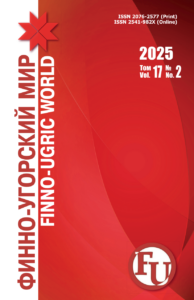Original article
DOI: 10.15507/2076-2577.013.2021.03.254-264
Archaic and innovative phenomena in the case paradigms of the Erzya dialects in the Volga region and the Southern Urals
Dmitry V. Tsygankin
Nina A. Agafonova
Ivan N. Ryabov
National Research Mordovia State University,
Saransk, Russia
Introduction. The modern differentiation of the Erzya dialects in the Volga region and the Southern Urals is the result of a long historical development. The migration of the Mordovians from their former places of residence contributed to their formation. The fact that in these regions the Erzya lived isolated from the rest of the Mordovians and contacted directly with peoples having different patterns of language contributed to preserving archaic phenomena of the base language and appearing innovative components in the structure of the dialects under study. The purpose of the work is to identify and describe archaic phenomena and innovations in the case paradigms of the study area.
Materials and Methods. The article is based on the field materials collected by the authors during linguistic expeditions in the places of concentration of the Erzya in the territory of the Volga region and the Southern Urals. The dialectal material was collected based on the questionnaire, reflecting the lexical, phonetic and morphological variations of linguistic phenomena. The descriptive and comparative historical methods were used to analyze language material.
Results and Discussion. The study of the linguistic material of the Volga region and the Southern Urals showed the differences in the case paradigms of the noun from the corresponding paradigms of the Erzya codified languages and other Mordovian dialects. In analysis showed that in the paradigms of the definite declension singular, there are different sets of cases and there is no single structure of word forms. Some paradigms are archaic, consistent, and logical. In the composition of others, new formations have developed, homonymous case suffixes and postpositional constructions have appeared.
Conclusion. The main dialect types of the Erzya languages were developed before the migration processes to the eastern territories of the modern residence of the Erzya. The isolated development of the dialects of the Volga region and the Southern Urals made it possible both to preserve archaic phenomena in the paradigms of the definite declension and to develop new formations uncharacteristic for them.
Keywords: the Erzya language, codified language, morpheme of certainty, dialect, case paradigm, archaic and innovative phenomena
Acknowledgments: The study was carried out with the financial support of the Russian Foundation for Basic Research within the framework of scientific project No. 19-012-00323.
For citation: Tsygankin DV, Agafonova NA, Ryabov IN. Archaic and innovative phenomena in the case paradigms of the Erzya dialects in the Volga region and the Southern Urals. Finno-ugorskii mir = Finno-Ugric World. 2021;13;3:254–264. (In Russ.). DOI: 10.15507/2076-2577.013.2021.03.254-264.
Information about the authors
D. V. Tsygankin – Doctor of Philology, Professor, Department of the Mordovian Languages, National Research Mordovia State University, kaferz@mail.ru, https://orcid.org/0000-0002-4806-2732
N. A. Agafonova – Candidate Sc. {Philology}, Associate Professor, Department of the Mordovian Languages, National Research Mordovia State University, ohanina@rambler.ru, https://orcid.org/0000-0001-8751-2751
I. N. Ryabov – Candidate Sc. {Philology}, Head of Department of the Mordovian Languages, National Research Mordovia State University, ryabov.74@bk.ru, https://orcid.org/0000-0001-6760-4376






















